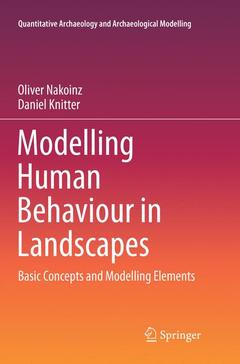Description
Modelling Human Behaviour in Landscapes, Softcover reprint of the original 1st ed. 2016
Basic Concepts and Modelling Elements
Quantitative Archaeology and Archaeological Modelling Series
Authors: Nakoinz Oliver, Knitter Daniel
Language: English
Subject for Modelling Human Behaviour in Landscapes:
Keywords
Agent-based models of complex systems; Analysis of point patterns; Geographical and social networks in Archaeology; Identifying border and cultural areas; Introduction to R software; Landscape archaeology; Monte Carlo Simulations; Open source statistical software; Predictive modelling; Quantitative Archaeology and Archaeological Modelling; Regression and interpolation methods; Simulation Models; Spatial analysis and statistics; Theoretical and empirical Interaction models; Theory of Modelling in archaeology; V
Approximative price 63.29 €
In Print (Delivery period: 15 days).
Add to cartPublication date: 04-2018
Support: Print on demand
Approximative price 89.66 €
In Print (Delivery period: 15 days).
Add to cartPublication date: 04-2016
Support: Print on demand
Description
/li>Contents
/li>Biography
/li>Comment
/li>
The book does not describe elaborated high-end models but rather very basic modelling concepts that serve as components in more complex models. The book enables the reader to construct such models by themselves and be sensitive for certain problems. In addition it gives hints for the interpretation of the results.
Students are usually quick to apply fancy methods yet fail in the proper interpretation due to a lack of understanding of the underlying principles. This problem is addressed by the proposed book through three concepts:
1. Command line software forces the students to first learn some details before they are able to produce results on their own.
The volume attempts to be an applied, minimalistic and efficient textbook and is based upon several successful courses.
Provides a comprehensive overview of basic modelling techniques
Includes open source software codes and data from real projects
Discusses the emergence and development of modelling in archaeology
Includes supplementary material: sn.pub/extras



